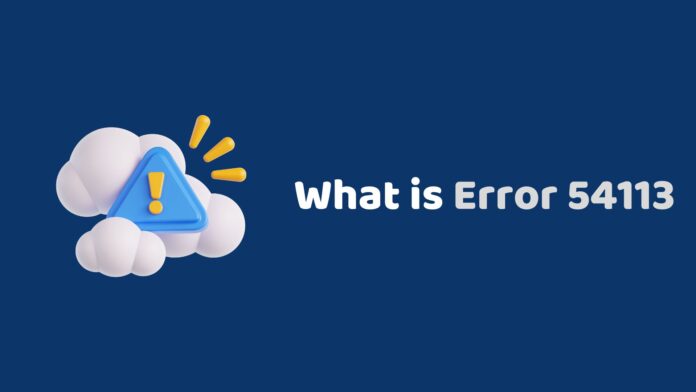Encountering Error 54113 can be frustrating, as it signals a snag in your system’s operation. This error code isn’t tied to a single application but pops up in various contexts.
Think of it as a digital distress signal, highlighting a problem with the way your system is processing information.
To get things back on track, you’ll need to investigate the underlying cause, which could range from incorrect settings to network hiccups.
What is Error 54113
Error 54113 is a specific error code that can occur in various software applications, systems, or platforms.
Although the exact nature and impact of this error can vary depending on the context in which it appears, it generally indicates a failure in the system’s operations or a problem with processing requests.
This error might be triggered by a wide range of issues, from server-side problems, configuration errors, to data processing failures. Understanding the root cause of Error 54113 is crucial for resolving it effectively and requires a detailed examination of the system’s log files, configuration settings, and operational environment.
Why 54113 Error Occurs
Error 54113 can occur for multiple reasons, each pointing towards underlying issues in the system’s infrastructure, software application, or external dependencies.
Common causes include incorrect configuration settings that prevent the system from operating as intended, software bugs that lead to unexpected behavior during execution, and compatibility issues that arise when integrating new components or updates.
Additionally, network-related problems, such as connectivity issues or server overload, can also trigger this error by disrupting normal communication and data exchange processes.
In some cases, insufficient user permissions or access rights may lead to Error 54113, as the system restricts certain operations to authorized users only. Understanding these potential causes is essential for diagnosing the error correctly and implementing an effective solution.
How to Fix Error 54113
Resolving Error 54113 involves a systematic approach to identify and address the underlying cause of the error. Here’re ways to fix this issue:
- Review System Logs: Start by examining the system’s log files for any warnings or error messages that occurred around the time the issue was reported. This can provide valuable clues about what went wrong.
- Check Configuration Settings: Ensure all configuration settings are correct and aligned with the system’s requirements. Misconfigured settings are a common source of problems.
- Update Software and Dependencies: Make sure all software applications and their dependencies are up to date. Installing updates can fix known bugs that might be causing the error.
- Test Network Connectivity: Verify network connections are stable and functioning correctly. Network issues can often result in errors during data transmission.
- Validate User Permissions: Confirm that all users experiencing the error have the appropriate permissions and access rights needed to perform the operation in question.
- Consult Documentation: Refer to the software’s official documentation or support forums for specific advice on resolving error 54113, as solutions may vary by application.
- Contact Support: If the problem persists, reach out to the software provider’s technical support team for professional assistance.
By following these steps, you can systematically diagnose and resolve Error 54113, restoring normal operation and minimizing disruptions to your system or application.
How to Prevent Error 54113 Occurs in Future
Preventing Error 54113 from occurring in the future requires proactive measures aimed at addressing the root causes of the issue. Implementing best practices in system management and maintenance is key.
Regularly updating software and dependencies ensures that the latest fixes and improvements are applied, reducing the risk of errors. Rigorous testing of configuration changes before deployment can catch potential issues that might lead to errors.
Establishing robust network monitoring and management protocols helps in identifying and mitigating connectivity issues promptly. Educating users about access rights and usage policies can prevent unauthorized actions that could trigger errors.
Additionally, maintaining comprehensive documentation on system configurations and procedures aids in understanding the setup and troubleshooting potential errors more effectively.
By adopting these preventive strategies, the likelihood of encountering Error 54113 can be significantly reduced, leading to a more stable and reliable system.
Is Error 54113 Harm to System?
Whether Error 54113 is harmful to a system largely depends on the context in which it occurs and the nature of the underlying issue. In most cases, this error code itself is a symptom of an underlying problem rather than a direct cause of harm.
However, if left unresolved, the conditions that lead to Error 54113 can potentially have negative impacts. For example, configuration errors or software bugs might lead to data processing issues, affecting the integrity or availability of the data.
Network connectivity problems could disrupt essential services, impacting user experience and system functionality. In severe cases, repeated errors could indicate a more systemic issue that, if not addressed, might lead to data loss, security vulnerabilities, or system instability.
Therefore, while Error 54113 might not directly harm the system, it serves as an important indicator that something needs attention to prevent possible adverse effects on the system’s performance and security.
Conclusion
While Error 54113 itself might not directly harm your system, it’s a red flag that shouldn’t be ignored.
Unresolved issues leading to this error could eventually cause data problems, service disruptions, or even security vulnerabilities.
The good news is, proactive measures can help you avoid this error code altogether. Keeping your software up-to-date, testing changes before they go live, and carefully managing configurations can go a long way in keeping your system running smoothly.

